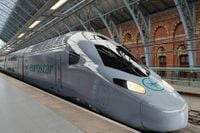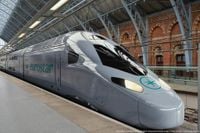Eurostar has unveiled ambitious plans to usher in a new era of cross-Channel rail travel, announcing a €2 billion investment in up to 50 state-of-the-art double-decker trains. The move marks the first time such high-speed, two-level trains will operate through the Channel Tunnel and on the UK’s rail network, signaling a bold step forward for international rail connectivity and sustainable travel in Europe.
The new fleet, christened Eurostar Celestia—a nod to the Latin word "caelestis," meaning "heavenly"—is being developed in partnership with French manufacturer Alstom. According to BBC News, the initial order consists of 30 trainsets, with an option for 20 more, all based on Alstom’s cutting-edge Avelia Horizon platform. Each 200-metre train will be fully interoperable across the five countries Eurostar currently serves: the UK, France, Belgium, the Netherlands, and Germany. The company is also eyeing future extensions to Geneva and Frankfurt, broadening its international reach.
Commercial service for the new trains is slated to begin in May 2031, following the delivery of the first six units earlier that year. Once the full order is realized, Eurostar’s fleet will swell to 67 trainsets, including the existing 17 single-decker e320s. This represents a 30% uplift in total fleet size, a move Eurostar says is essential to its ambitious goal of carrying 30 million passengers annually—a significant jump from the 19.5 million recorded last year.
Eurostar CEO Gwendoline Cazenave expressed her excitement over the milestone, telling Railway-News: “Placing this milestone order marks the concrete realisation of Eurostar’s ambitious growth strategy—to reach 30 million passengers by investing in a brand-new fleet. We’re particularly proud to bring double-decker trains to the UK for the very first time. Customers can expect a very special new train with Eurostar Celestia, which will offer exceptional comfort, a unique Eurostar experience and new surprises to be revealed. This is a golden age for international sustainable travel—and Eurostar is leading the race.”
Each Celestia train will seat around 540 passengers, about 20% more than the current generation, and can operate in tandem to form 400-metre, 1,080-seat services. The design process has included input from passenger and accessibility groups, as well as over 100 Eurostar team members, ensuring that the new trains will offer enhanced comfort, more legroom, and improved spaces for bikes and wheelchair users. Notably, all classes of travel will allow passengers to choose between the upper or lower deck at no additional cost.
The all-electric Celestia fleet is designed with sustainability at its core. According to Eurostar, the trains will incorporate 97% recyclable components, with a quarter made from recycled materials. Energy consumption is expected to be 20–50% lower than the current fleet, and the design takes into account long-term climate resilience. Alstom CEO Henri Poupart-Lafarge highlighted the significance of the project, stating to The Independent: “By choosing Avelia Horizon to renew its fleet, Eurostar is confirming its desire to combine technological performance, energy efficiency and passenger comfort. This new-generation train, designed to meet the demands of international very high-speed traffic, embodies our vision of sustainable and competitive European mobility.”
Maintaining such a sophisticated fleet requires world-class facilities. Eurostar will upgrade its Temple Mills depot in east London with an €80 million investment to support the new trains. This expansion is expected to create around 350 additional engineering and maintenance roles, reinforcing the site’s status as a hub for high-speed rail expertise. However, as BBC News reports, questions remain over whether the facility can accommodate both Eurostar and potential rival operators, as the depot is currently the only one in the UK capable of handling the larger trains used on continental networks. The Office of Rail and Road is currently reviewing proposals from other companies—including Spanish start-up Evolyn, Sir Richard Branson’s Virgin, and a partnership between Gemini Trains and Uber—who are eager to launch their own cross-Channel services. A decision on depot access is expected within weeks.
The introduction of double-decker trains through the Channel Tunnel is a historic milestone for Britain’s railways. The only previous double-decker passenger service in the UK was a short-lived experiment in the 1950s and 1960s, withdrawn in 1971 due to cramped conditions and high maintenance costs. Double-decker trains are common on the continent, but the majority of Britain’s rail network cannot accommodate them due to low bridges and tunnels—obstacles stemming from the country’s Victorian-era infrastructure. Pete Waterman, music producer and train enthusiast, told the BBC that while Eurostar’s move is laudable, “most of British railways you can’t put double deckers on because our railways were built 200 years ago.” The high-speed line between St Pancras and the Channel Tunnel, however, was constructed to European standards, making it uniquely suited for these larger trains.
The Celestia trains will stand 4.33 metres high—16 centimeters taller than the current e320 models—and feature a lower floor to maximize interior space. While the double-decker design doesn’t quite double the seating capacity compared to single-deckers (due to the need for internal staircases and extra space), the 20% increase is a significant boost, especially on busy international routes. Eurostar says the new trains will also feature "surprise spaces," though further details have yet to be revealed.
The move to expand and modernize comes at a time of growing competition. For the first time in its history, Eurostar may soon face rival operators running passenger trains through the Channel Tunnel. The company, now majority-owned by the French state railway SNCF after the UK sold its stake in 2015, is determined to stay ahead by investing in a bespoke, future-proof fleet. As Gwendoline Cazenave put it, Eurostar is “leading the race” to meet the surging demand for international train travel.
Looking ahead, Eurostar’s expansion plans include not only new rolling stock but also new destinations. The company has announced intentions to launch direct services from London to both Frankfurt and Geneva in the coming years, further solidifying its role as a linchpin in European rail travel. The new double-decker Celestia fleet, with its blend of capacity, comfort, and sustainability, is poised to transform the experience of crossing the Channel for millions of passengers each year.
As the countdown begins to the arrival of the first Celestia trains in 2031, the stage is set for a new chapter in the story of European rail—a chapter defined by innovation, competition, and a renewed commitment to sustainable, high-speed travel.


